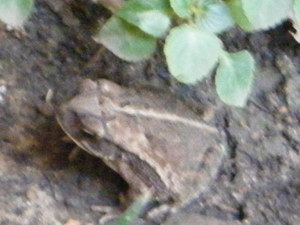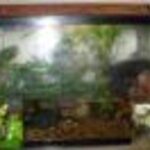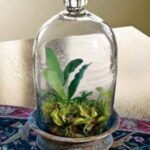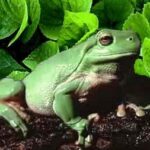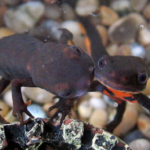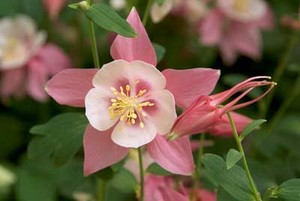What is a terrarium? A terrarium is a small contained eco-system used to grow plants. Small amphibians can be added, along with fish to make a rainforest type living habitat. The species of amphibians should be docile and reclusive such as frogs, toads, salamanders and newts. These amphibians remain small enough that they will not outgrow the terrarium. The type of plants used to fill your terrarium should be water loving bog plants. Moss, lichen, miniature ferns are good choices along with begonias and African violets. These soggy loving plants are manageable within a terrarium when pruned to prevent over growth. If fish are desired, add small species such as guppies. Guppies are great for terrariums since they eat water insects, waste matter and the mites that can breed within the moist environment. If fish are added to the amphibian terrarium, feed the amphibians often to keep them from eating the small fish as dinner.
Use an old aquarium tank large enough for the amphibians to live comfortably. A pool of water can be made by dividing the terrarium with a glass partition that epoxies to the tank. A leak proof bowl can also be used, just set in the terrarium and add a layer of pebbles to the bottom. Add water to the bowl or partitioned area.
Around the bowl, add 1 inch of pebbles to the bottom of the aquarium to aid in drainage. On top of the pebbles add a ½ inch layer of activated charcoal, this will aide in maintaining cleaner air and water. The next layer should be sphagnum moss as this will keep the soil from falling into the cracks between the charcoal and pebbles. Spread the soil, 2 inches in depth, as the top layer.
Place the plants within the terrarium with the taller plants to the back of the tank. Shorter plants can be added to the middle or around edges of tank. Do not let the leaves touch the side of the tank as this can cause mildew or rot on the plants, due to moisture on the glass. Bunch some plants together to form hideaways for the amphibians to use.
Set stones close together to form a cave area big enough to house the amphibians. Amphibians may need to use a basking spot to warm themselves as they are coldblooded. A heat lamp set up above a piece of driftwood or a large flat topped rock is an ideal way to create a basking spot within the terrarium. A thermometer will be needed in the tank to monitor the heat. An under tank additional heating source can be used to help regulate temperature inside the terrarium at night or during colder months.
Mist the soil and plants with a garden mistier and add fish and amphibians to the terrarium. Cover the top with a tightly fitting ventilated hood, unless you want to spend time getting exercise by playing hide and seek with escapees.
Keep your terrarium away from direct sunlight as it can over heat the tank, killing plants, fish and amphibians. Be aware of using dirt or beach sand in the terrarium, as these can contain toxins and harm the amphibians. Do not over crowd your terrarium with to many plants and amphibians as this may cause fighting. Always cover heat lamps to prevent the amphibians from getting burns. With these precautions your amphibian terrarium will be an enjoyable for your little creatures to live and for you to watch.
Source:
UV Guide: What UV Light Do Reptiles Need
http://www.uvguide.co.uk/whatreptilesneed.htm
HealthyPets.com: Entirely Reptileshttp://www.uvguide.co.uk/whatreptilesneed.htm
